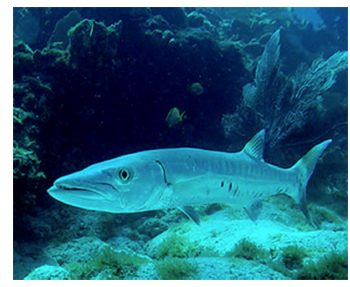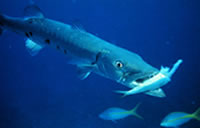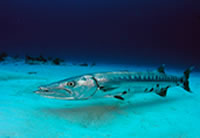The Great Barracuda
Sphyraena barracuda

Taxonomy
Kingdom: Animalia
Phylum: Chordata
Class: Actinopterygii
Order: Perciformes
Family: Sphyraenidae
Genus: Sphyraena
Species: Barracuda
Common name: The Great Barracuda
Scientific name: Sphyraena barracuda
Average size: 38 kg (83 pounds), 6 feet in length
Depth: 6-45 ft (2-15m), usually near surface but have been spotted at 90ft below
Longevity: At least 14 years
Distribution: Caribbean, Western Atlantic, and Pacific Ocean. Generally 30°N and 30°S
Life history/ecology:
Habitat and morphology: The great barracuda tends to inhabit the tropics, the sub-tropics, the shallow waters with submerged coral reefs, coasts, open seas, and mangroves. Whether nearby an underwater wreck or coral reef, one will find many marine species such as the anemones, jelly fish, sting rays, colorful fish, and of course the great barracuda swimming around looking for its chance to strike its prey. The great barracuda typically swims in solitude but occasionally will be found in a large school in order to facilitate attack on a group of smaller fish. When juvenile, the great barracuda exhibits a green/brown color to blend in with the shallow grassy waters, but when the great barracuda matures it exhibits a grey/silvery color to blend in with the shimmery open ocean habitat. They use different coloring patterns to camouflage themselves for protection and to enhance predation. Once a great barracuda reaches adulthood it no longer grows in length anymore but will continue to grow in width. The adult barracuda has a pointed head with large, teeth revealing mouth attached to a long, lean body. They also have dark spots on the side of their bellies along with a few faded white striped markings. It is also nearly impossible to tell a female and male great barracuda species apart.
 Behavior: The great barracuda is considered to be the dominant predator of these tropical marine waters that which attacks its prey at great speeds of up to 30m/s. The great barracuda has a jaw so strong, vision so clear, and teeth so evident and sharp that no species could stand a chance of getting away once trapped. All these features make the great barracuda an extremely successful predator. Other than solitarily striking its prey, a great barracuda also hunts its prey by swimming in large groups circling and trapping schools of smaller fish. The great barracuda would begin its strike with a sudden acceleration towards its prey and snapping its jaws shut around its prey. Then it would use its razor sharp teeth and the vigorous shaking of its head to break the prey in several pieces. When not attacking, they like to slowly drift through the open water observing its environment in silence and peace. The great barracuda is attracted to shiny objects, such as earrings, necklaces, and belly rings because its prey is usually of shiny grey color. It is wise for any person scuba diving or snorkeling around a group of great barracudas to take off any jewelry that could potentially cause a great barracuda to mistake it for food to attack. The great barracuda rarely attacks humans but this usually only happens when it is provoked and rarely is a deadly case.
Behavior: The great barracuda is considered to be the dominant predator of these tropical marine waters that which attacks its prey at great speeds of up to 30m/s. The great barracuda has a jaw so strong, vision so clear, and teeth so evident and sharp that no species could stand a chance of getting away once trapped. All these features make the great barracuda an extremely successful predator. Other than solitarily striking its prey, a great barracuda also hunts its prey by swimming in large groups circling and trapping schools of smaller fish. The great barracuda would begin its strike with a sudden acceleration towards its prey and snapping its jaws shut around its prey. Then it would use its razor sharp teeth and the vigorous shaking of its head to break the prey in several pieces. When not attacking, they like to slowly drift through the open water observing its environment in silence and peace. The great barracuda is attracted to shiny objects, such as earrings, necklaces, and belly rings because its prey is usually of shiny grey color. It is wise for any person scuba diving or snorkeling around a group of great barracudas to take off any jewelry that could potentially cause a great barracuda to mistake it for food to attack. The great barracuda rarely attacks humans but this usually only happens when it is provoked and rarely is a deadly case.
Nutrition and symbiosis: The great barracuda typically feeds on herring, shrimp, sardine, puffer fish, octopus, and small tuna. The great barracuda has no threats except the occasional dolphin or shark. While watching its environment when floating around the marine environment, the great barracuda is taking part of a mutualistic relationship with cleaner wrasse. It generally has its mouth partly open and gills flared out to allow the cleaner wrasse to eat dead skin and parasites off of the surface of the great barracuda.
 Danger and recent research: The main danger associate with the great barracuda is ciguatoxin, a toxin found in barracuda flesh. This toxin causes ‘human ciguatera fish poisoning’ and therefore consumers are suggested to eat barracuda meat with serious caution due to the possible neurological, gastrointestinal, and cardiac issues that could occur shortly afterwards. Symptoms include diarrhea, stomach cramps, and vomiting 3-6 hours after eating the infested meat. Research indicates that this toxin is caused from the photosynthetic, toxin-producing algae dinoflagellate species that which the great barracuda eats. The great barracuda has been used in research studies regarding this toxin and has been helpful in understanding ciguatoxin. This toxin is also found in other large reef fish such as the grouper, red snapper, eel, amberjack, sea bass, and the Spanish mackerel. The toxin is heat resistant and only causes harm to humans, not other fish. More research will eventually allow for the humans to improve management and treatment of this poison.
Danger and recent research: The main danger associate with the great barracuda is ciguatoxin, a toxin found in barracuda flesh. This toxin causes ‘human ciguatera fish poisoning’ and therefore consumers are suggested to eat barracuda meat with serious caution due to the possible neurological, gastrointestinal, and cardiac issues that could occur shortly afterwards. Symptoms include diarrhea, stomach cramps, and vomiting 3-6 hours after eating the infested meat. Research indicates that this toxin is caused from the photosynthetic, toxin-producing algae dinoflagellate species that which the great barracuda eats. The great barracuda has been used in research studies regarding this toxin and has been helpful in understanding ciguatoxin. This toxin is also found in other large reef fish such as the grouper, red snapper, eel, amberjack, sea bass, and the Spanish mackerel. The toxin is heat resistant and only causes harm to humans, not other fish. More research will eventually allow for the humans to improve management and treatment of this poison.
Reproduction: Reproductive practices of the great barracuda are largely unknown. The great barracuda exhibits external fertilization, where they release eggs and sperm into the currents, which then after fertilization enter the estuaries. After fertilization, the larvae will remain in the estuary until they mature. After maturation, the mature great barracuda ventures out into the open ocean. Male great barracudas reach sexual maturity prior to the female species when they are two years old. The way their reproduce and how often they reproduce is still unknown.
Economical services: Although there is no commercial use for the great barracuda, people like to esteem the great barracuda as a game fish. The great barracuda is an extremely fun fish to reel in on a boat or shore making it a challenge for fishermen out there. Other than this, the great barracuda is extremely helpful in the research regarding the ciguatoxins that it may or may not contain.
Personal interest: Ever since I got certified as a scuba diver 7 years ago I’ve come in contact with the marine life more than I could have ever dreamed of. The great barracuda has always been the most fascinating fish I had come in contact with. Prior to every dive, I had to prepare myself for dives more than usual since I have several piercings and was always told to take them out just in case the great barracuda were to mistake me for food. Perhaps the reason I’ve always been so fascinated with the great barracuda is because they’re the most dangerous predators that I’ve seen out in the open ocean since I’ve never gotten the privilege to see a shark in the wild. I’ve definitely learned a whole lot more about the great barracuda and look forward to seeing it in Belize.
Work Cited
1. “FLMNH Ichthyology Department.” Great Barracuda, n.d. Web. 29 May 2012.< http://www.flmnh.ufl.edu/fish/gallery/descript/greatbarracuda/greatbarracuda.html>.
2. “Ciguatera Toxin (Fish Poison).” Emedicine Health, n.d. Web. 29 May 2012. <http://www.emedicinehealth.com/wilderness_ciguatera_toxin/article_em.htm>.
3. “Sphyraena barracuda.” The Great Barracuda, n.d. Web. 29 May 2012.< http://bioweb.uwlax.edu/bio203/s2008/sellnow_hann/>.
4. “The Great Barracuda- Final Draft.” The Great Barracuda, n.d. Web. 29 May 2012.< http://jrscience.wcp.muohio.edu/fieldcourses08/PapersMarineEcologyArticles/TheGreatBarracuda-FinalDr.html>.
External Links
http://www.youtube.com/watch?v=vfv5IgNmV94
http://www.youtube.com/watch?v=SNz9KmI5jCk